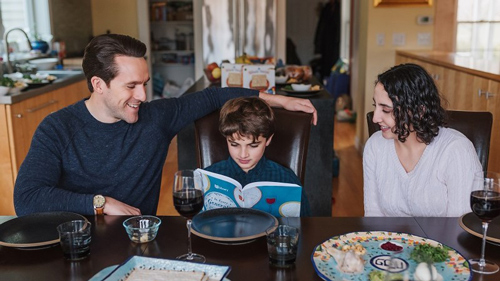
Many families are going to be leading Passover seders for the first time this year. You might be used to attending an extended family or community seder and just bringing a side dish, leaving all the preparation to the hosts. If organizing, cooking, and leading your own seder is new to you, here's a quick guide with some tips to help keep your Passover easy and stress-free.
Make it personal
Begin in a personal way. Talk about how families all over the world, despite world events or personal struggles, are pausing to celebrate Passover. Ask your family what they wish for most in this time, what they’re grateful for, or what discoveries they’ve made in the past year.
Make it simple
Start your seder with simple rituals – some that your family may practice during the year, others that are unique to Passover. The traditional ones are: lighting candles; blessing your children; making kiddush (blessing over wine or grape juice); washing hands (more symbolic than ever!), dipping parsley in salt water and eating it; and breaking the middle matzah of three pieces of matzah (and then, when the opportunity arises, hiding half as the afikomen, the hide-and-seek matzah).
You don’t need to do all of these opening rituals, and you can certainly do them in your own style (traditional blessings or not, additional explanations or not). The key is: Involve your children as much as you can in each ritual.
Make it a story
Move to the heart of the matter – storytelling about a journey to freedom. We warm up to the story with two particularly child-oriented practices. The youngest child or children say "Ma Nishtana," the Four Questions, in which paying attention to Passover practices on display (matzah, dipping – what are these about?) begs an answer in the form of a story. Then we describe Four Children, each of whom is a different sort of learner. This gives you license to go ahead and tell the Passover story in the way that fits your family’s learning style best.
And on to telling the story. As PJ Library parents, you have experience with this. What’s the family storytelling experience you want to create? You can simply follow the four-part illustrated summary on pages 31-35 of the PJ Library Family Haggadah, accompanied by discussion and drama prompts. Or have your kids tell the story in their own way. (Use the PJ Library River Ride as a storytelling aide.) Or act it out as a family, with costumes, stuffies, finger puppets, props (which doll is in the basket playing Baby Moses? what serves as Moses’ staff?). Turn the story into a game show. Read a PJ Library Passover book. Juxtapose the Exodus story with a family member’s or friend’s personal journey to freedom. It’s totally up to you.
The storytelling portion of the seder can be a lot of fun. It can also generate questions, and part of the excitement of a seder is when new questions and topics are explored in the course of telling this ancient story. Encourage your children’s questions, and don’t hesitate to ask your own as well.
The storytelling portion of the seder ends on two notes – calling out the list of Ten Plagues and celebrating the miraculous crossing of the sea, which is great fun to act out and is capped off by the singing of “Dayenu” and other freedom songs. (And for kids with energy to spare, doing a free-style dance interpretation of the phrase “We’re free!”)
Make it noshable
Ramp up to the Passover meal through a series of traditional appetizers. These include: grape juice (second cup), matzah (first bite on Passover!), bitter herbs (dipped in charoset, the sweet mortar-like mixture – the “second dipping”), and the Hillel sandwich (bitter herbs and charoset on a piece of matzah) – each with its own blessing and explanation, if so desired. Then, dinner is served. And after dinner, comes dessert (or the post-dessert dessert): Kids search for the afikomen, get a prize for finding it, and share it with everyone, so the last bite of the evening is a small crunchy send-off.
Make it yours
For many families, dayenu – this is enough! You’ve told the story, celebrated, and stuffed yourselves. Time for bed. For other families, there are post-dinner goodies – a blessing after meal, opening the door for Elijah, two more cups of grape juice, and fun family songs like “Echad Mi Yode’a” (counting song) and “Chad Gadya” (animal song). Every family will figure out which of these elements is important for their family celebration, bearing in mind a wondrous fact:
There’s always next year. (Or as we say: Next year in Jerusalem!)